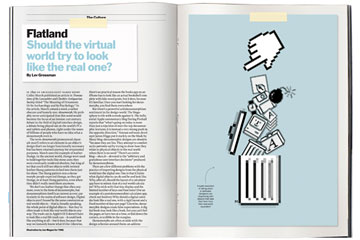
(2 of 3)
There are a few different problems with the practice of importing designs from the physical world into the digital one. One is that it limits what digital objects can do and be and look like. Why, after all, should the layout of a calculator app have to mimic that of a real-world calculator? Why stick with that tiny display and the limited number of keys and functions? (For an example of a postskeuomorphist calculator app, check out Soulver.) Why should a digital calendar look like a real one, with a rigid layout and a fixed number of days per page? Likewise, skeuomorphic designs create false expectations. A digital book may look like a book, but you can't feel the pages, or turn two at a time, or fold down the corners, or scribble in the margins.
Skeuomorphs are often at odds with the design schemes around them: an address book with a fake-leather theme clashes with an operating system built out of brushed-metal textures. They also tend to be busy and detail-heavy; that's a particular problem on mobile phones, where displays are small and computing resources are limited. In April, Facebook subtly altered its iconic F logo, taking out the little glossy highlight bar at the bottom, thus turning it from a fake three-dimensional object into an avowedly flat two-dimensional object. That was a blow against skeuomorphism.
The revolt will culminate in June at Apple's Worldwide Developers Conference, where the company is expected to unveil iOS7 and OS X 10.9, redesigned versions of its two flagship operating systems. Last October, in a corporate shake-up, Apple handed control of its software design to Jonathan Ive, who had long been chief of the company's hardware design. Ive is deeply committed to a design philosophy of simplicity that unites form and function and context. Apple is famous for not commenting on its works in progress, but if the rumors on the many fanatical Apple-watching blogs--invariably sourced to anonymous insiders--are anywhere near true, Ive is ruthlessly purging all remaining skeuomorphic elements from Apple's operating systems, thereby plunging users into a brave and very flat new world.
Which is Ironic, because apple is a house built on skeuomorphism. When Steve Jobs shepherded the original Macintosh to market in 1984, he was the first to successfully introduce consumers to the idea of a graphical user interface, or GUI (you say it gooey). Before that, most computers confronted users with a naked command line where they were expected to type out their instructions as raw text. The Macintosh offered a user-friendly alternative: a crude digital rendering of a desktop, with windows and documents and folders and a trash can, all aimed at skeuomorphically mimicking the real physical work environment we're used to. It was a revolution. The Macintosh GUI did what skeuomorphs do so well: it made an unfamiliar environment feel safe and easy.
Ever since, Apple's software has been littered with skeuomorphs and other details derived from the real world: brushed-steel textures, glossy highlights, candy-colored buttons, three-dimensional shadows and reflections. Legend has it that the skeuomorphic leather-stitching pattern in iCal, the calendar application that comes with OS X, is based on the upholstery in Jobs' Gulfstream jet.
